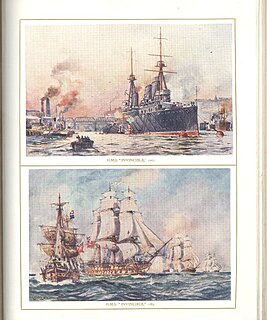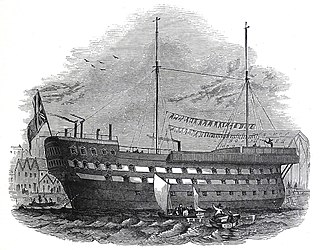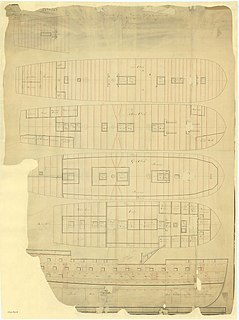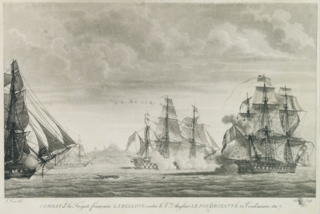HMS Thunderer was a ship of the line of the Royal Navy, built in 1783. She carried 74-guns, being classified as a third rate. During her service she took part in several prominent naval battles of the French Revolutionary Wars and the Napoleonic Wars; including the Glorious First of June, the Battle of Cape Finisterre and the Battle of Trafalgar.

HMS Invincible was a 74-gun third-rate ship of the line of the Royal Navy, launched on 9 March 1765 at Deptford. Invincible was built during a period of peace to replace ships worn out in the recently concluded Seven Years' War. The ship went on to serve in the American War of Independence. May, 1778 under command of Capt. Anthony Parry. Fought at the battles of Cape St Vincent in 1780, and under the command of Captain Charles Saxton, the Battles of the Chesapeake in 1781 and St Kitts in 1782.

HMS Hannibal was a 74-gun third-rate ship of the line of the Royal Navy, launched on 15 April 1786, named after the Carthaginian general Hannibal. She is best known for having taken part in the Algeciras Campaign, and for having run aground during the First Battle of Algeciras on 5 July 1801, which resulted in her capture. She then served in the French Navy until she was broken up in 1824.

HMS Warrior was a 74-gun Alfred-class third-rate ship of the line of the Royal Navy, launched on 18 October 1781 at Portsmouth.

HMS Monmouth was a 64-gun third rate ship of the line of the Royal Navy, launched on 23 April 1796 at Rotherhithe. She had been designed and laid down for the East India Company, but the Navy purchased her after the start of the French Revolutionary War. She served at the Battle of Camperdown and during the Napoleonic Wars. Hulked in 1815, she was broken up in 1834.

HCS Bombay, later HMS Bombay and HMS Ceylon, was a teak-built fifth rate, 38-gun wooden warship built in the Bombay Dockyard for the Honourable East India Company (HEIC) and launched in 1793. The Royal Navy purchased her in 1805 and renamed her HMS Bombay. She served with the Royal Navy under that name until 1 July 1808, when she became HMS Ceylon. She was sold at Malta in 1857 and broken up in 1861.

Bellone was an Iphigénie-class 32-gun frigate of the French Navy on plans by Léon-Michel Guignace. She took part in the American Revolutionary War in the Indian Ocean with the squadron under Suffren, and later in the French Revolutionary Wars. She was present at the Glorious First of June.
Clorinde was a 44-gun Uranie-class frigate of the French Navy. The Royal Navy captured her in 1803 and took her into service as HMS Clorinde. She was sold in 1817.

Piémontaise was a 40-gun Consolante-class frigate of the French Navy. She served as a commerce raider in the Indian Ocean until her capture in March 1808. She then served with the British Royal Navy in the East Indies until she was broken up in Britain in 1813.

HMS Lowestoffe was a 32-gun fifth-rate frigate of the Royal Navy. Built during the latter part of the Seven Years' War, she went on to see action in the American War of Independence and the French Revolutionary War, and served often in the Caribbean. A young Horatio Nelson served aboard her shortly after passing his lieutenant's examination.

Sylphe was an Abeille-class 16-gun brig-corvette of the French Navy. The class was built to a design by François Pestel. The British captured her in 1807 and took her into the Royal Navy as HMS Seagull, but apparently never used her in any capacity. She was sold in 1814.

HMS Porcupine was a 24-gun Porcupine-class sixth-rate post ship of the Royal Navy built in 1777 and broken up in 1805. During her career she saw service in the American War of Independence and the French Revolutionary Wars.

Terrible was originally a 74-gun ship of the line of the French Navy launched in 1739. Captured on 14 October 1747, she was taken into Royal Navy service as the third rate HMS Terrible.

HMS Monarch was originally the 74-gun ship of the line Monarque of the French Navy launched in March 1747. Captured on 14 October 1747, she was taken into Royal Navy service as the third rate HMS Monarch.

HMS Prince William was a 64-gun third-rate ship of the line of the Royal Navy. She had previously been Nuestra Señora de la Asunción, but was better known as Guipuzcoano, an armed merchantmen of the Spanish Basque Guipuzcoan Company of Caracas.

HMS Pakenham (G06) was a P-class destroyer of the British Royal Navy built and operated during World War II. Commissioned in early 1942, she took part in the invasion of Madagascar, and several Malta Convoys, before being disabled in a battle with Italian torpedo boats in April 1943 and scuttled.

HMS Ceres was an 18-gun sloop launched in 1777 for the British Royal Navy that the French captured in December 1778 off Saint Lucia. The French Navy took her into service as Cérès. The British recaptured her in 1782 and renamed her HMS Raven, only to have the French recapture her again early in 1783. The French returned her name to Cérès, and she then served in the French Navy until sold at Brest in 1791.

Brillant was a Téméraire-class 74-gun ship of the line of the French Navy. The British captured her while still on keel, ready for launch, at the fall of Genoa in 1814. She was completed for the Royal Navy and served as HMS Genoa until 1838. On 20 October 1827 Genoa took part in the Battle of Navarino where her captain Walter Bathurst was killed.

HMS Resistance was a 44-gun fifth-rate Roebuck-class ship of the Royal Navy launched in 1782. Based on the design of HMS Roebuck, the class was built for use off the coast of North America during the American Revolutionary War. Commissioned by Captain James King, Resistance served on the West Indies Station for the rest of the war. She captured the 24-gun corvette La Coquette on 2 March 1783 and then went on in the same day to participate in the unsuccessful Battle of Grand Turk alongside Horatio Nelson. Resistance then went for a refit in Jamaica, during which time King fell ill and was replaced by Captain Edward O'Bryen. O'Bryen commanded Resistance until March 1784 when she was paid off. In 1791 she was recommissioned as a troop ship, but was converted back into a warship in 1793 at the start of the French Revolutionary War, under Captain Edward Pakenham.

The Narcissus-class frigate was a 32-gun, 18-pounder fifth-rate frigate class of five ships of the Royal Navy. Designed by Surveyor of the Navy Sir John Henslow, the class was created to make use of shipyards that could not construct larger frigates. They were similar in design to the preceding 32-gun frigate class, the Amphion class, but were slightly shorter. Two ships were initially constructed, with a later batch of three being ordered in response to an Admiralty request for the resumption of production of proven frigate designs. The final two ships of the class were cancelled when the shipyard they were being constructed at went bankrupt. Unlike her sister ships, the name ship of the class Narcissus was armed with experimental short 24 pounders rather than 18 pounders.

















